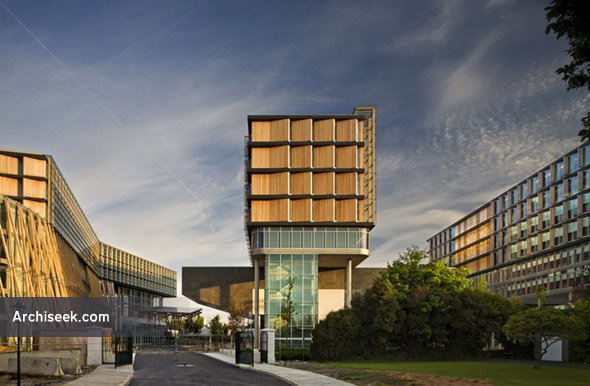2008 – Elmpark, Co. Dublin

A continuous garden covers the ground floor level. The buildings overhead define different areas within this garden, with ‘courtyards’ oriented on the north–south axis relating to the individual buildings each taking on a character of its own, framing different views of the mountains beyond and providing orienting ‘reference points’ within the overall scheme. The garden areas are ‘stratified‘ from north to south to create a hard-landscaped area to the north where taxis and other vehicles can drop off passengers at the individual buildings, a public concourse where people can circulate between buildings and a slightly lower area for informal meetings etc.
The Elm Park Development is low energy. The entire project includes a combined heat and power generation system, fuelled by woodchip biomass, – electricity is generated on site and hot water supplied to apartments as a by-product. All the buildings utilise their orientation to maximise wind-driven ventilation, and to benefit from solar energy.
The office buildings are designed as climate controlled buildings, without the use of mechanical ventilation or air conditioning ; the building’s fabric and form have been composed to produce an environment which is physiologically balanced with human’s need for comfort, and minimizes the use of energy. The building’s large west facing ‘thin atria’ act as ventilation lungs for the building, maintaining the internal temperatures comfortably low.
Three linear office buildings are arranged in a number of shallow depth, 8-storey high blocks orientated along the north to south axis. The block depth and orientation help to make the most of natural ventilation and daylighting, to greatly reduce the energy consumption of the buildings whilst creating a pleasant working environment for employees. Wind forces are used to drive the natural ventilation strategy.
Thin atria at alternate sides of the office blocks provide entrances and allow the gardens to continue vertically up through the offices and also provide stack effect ventilation which encourages the natural flow of air. The massing of the blocks is broken by large winter gardens through each block and the stepping of each block at the north and south ends. These winter gardens also help to provide light to the courtyards between the offices. Plant areas are located in the parking levels below ground.
Timber has been employed extensively on the project as both structure and cladding. Within the facades most of the long-span structural elements are composed of glu-laminated timber, engineered as supports of the breathing facades.
The entire project benefits from a shared solution to energy generation; a Combined Heat and Power plant turns heat energy into power to supply the power needs of the office buildings. A wood pellet boiler supplies hot water for heating the apartments and the offices. An energy management strategy moves energy around according to demand: excess heat can be stored in the swimming pool, used to heat the apartments during the evening, or offices during the day.






